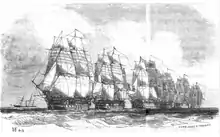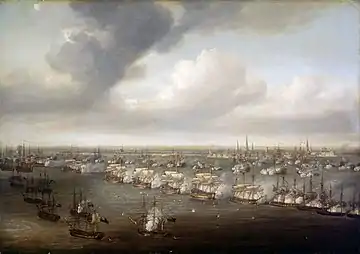Line of battle
In naval warfare, the line of battle is a tactic in which a naval fleet of ships forms a line end to end. Its first use is disputed, variously claimed for dates ranging from 1502 to 1652, with line-of-battle tactics in widespread use by 1675.


Compared with prior naval tactics, in which two opposing ships closed on one another for individual combat, the line of battle has the advantage that each ship in the line can fire its broadside without fear of hitting a friendly ship. Therefore, in a given period, the fleet can fire more shots.
Another advantage is that a relative movement of the line in relation to some part of the enemy fleet allows for a systematic concentration of fire on that part. The other fleet can avoid this by maneuvering in a line itself, with a result typical for sea battle since 1675: two fleets sail alongside one another or on the opposite tack.
A ship powerful enough to stand in the line of battle came to be called a ship of the line (of battle) or line of battle ship, which was shortened to become the word battleship.[1]
Development
.jpg.webp)
The first recorded mention of the use of a line of battle tactic is attested from 1500. The Instructions provided in 1500 by King Manuel I of Portugal to the commander of a fleet dispatched to the Indian Ocean suggests its use predated the written instructions. Portuguese fleets overseas deployed in line ahead, firing one broadside and then putting about in order to return and discharge the other, resolving battles by gunnery alone. In a treatise of 1555, The Art of War at Sea, Portuguese theorist on naval warfare and shipbuilding, Fernão de Oliveira, recognized that at sea, the Portuguese "fight at a distance, as if from walls and fortresses...". He recommended the single line ahead as the ideal combat formation.[2]
A line-of-battle tactic had been used by the Fourth Portuguese India Armada in the Battle of Calicut, under Vasco da Gama in 1502, near Malabar against a Muslim fleet.[3] One of the earliest recorded deliberate use is also documented in the First Battle of Cannanore between the Third Portuguese India Armada under João da Nova and the naval forces of Calicut, earlier in the same year.[4] Another early, but different form of this strategy, was used in 1507 by Afonso de Albuquerque at the entrance to the Persian Gulf, in the first conquest of Ormuz. Albuquerque commanded a fleet of six carracks manned by 460 men, and entered Ormuz Bay, being surrounded by 250 warships and a 20,000 men army on land. Albuquerque made his small fleet (but powerful in its artillery) circle like a carrousel, but in a line end-to-end, and destroyed most of the ships that surrounded his squad. He then proceeded to capture Ormuz.
While it is well documented that Maarten Tromp first used it in the Action of 18 September 1639,[5] some have disputed this.[6] One of the first precise written instructions in any language adopting the formation were contained in the English Navy's Fighting Instructions, written by Admiral Robert Blake and published in 1653.[6] Individual captains on both sides of the First Anglo-Dutch War appear to have experimented with the technique in 1652, possibly including Blake at the Battle of Goodwin Sands.[6]
From the mid-16th century the cannon gradually became the most important weapon in naval warfare, replacing boarding actions as the decisive factor in combat. At the same time, the natural tendency in the design of galleons was for longer ships with lower castles, which meant faster, more stable vessels. These newer warships could mount more cannons along the sides of their decks, concentrating their firepower along their broadside.
Until the mid-17th century, the tactics of a fleet were often to "charge" the enemy, firing bow chaser cannon, which did not deploy the broadside to its best effect. These new vessels required new tactics, and "since ... almost all the artillery is found upon the sides of a ship of war, hence it is the beam that must necessarily and always be turned toward the enemy. On the other hand, it is necessary that the sight of the latter must never be interrupted by a friendly ship. Only one formation allows the ships of the same fleet to satisfy fully these conditions. That formation is the line ahead [column]. This line, therefore, is imposed as the only order of battle, and consequently as the basis of all fleet tactics."[7]
The line-of-battle tactic favored very large ships that could sail steadily and maintain their place in the line in the face of heavy fire. The change toward the line of battle also depended on an increased disciplining of society and the demands of powerful centralized government to keep permanent fleets led by a corps of professional officers. These officers were better able to manage and communicate between the ships they commanded than the merchant crews that often comprised large parts of a navy's force. The new type of warfare that developed during the early modern period was marked by a successively stricter organization. Battle formations became standardized, based on mathematically calculated ideal models. The increased power of states at the expense of individual landowners led to increasingly larger armies and navies.[8]
Effective use
The line of battle was marked by tactical rigidity and often resulted in indecisive engagements. Fleet commanders sometimes met with greater success by altering or abandoning the line of battle outright by breaking the enemy line and moving through it (e.g. Four Days Battle, Battle of Schooneveld, Battle of Trafalgar), by trying to cut off and isolate part of the enemy's line while concentrating a stronger force on it (e.g. Battle of Texel, Battle of the Saintes), or by trying to "double up" the enemy's ships (e.g. Battle of Beachy Head, Battle of the Nile).
Weaknesses
The main problem with the line of battle was that when the fleets are of similar size, naval actions using it were generally indecisive. The French in particular were adept at gunnery and would generally take the leeward position to enable their fleet to retire downwind while continuing to fire chain-shot at long range to bring down masts. Eventually so many vessels in a line would be damaged that they would be forced to retire for repairs while the French took few casualties and very little damage themselves.
Doubling
If the opposing fleets were of similar size, a portion of the line might be overwhelmed by focused gunfire of the entire enemy line by doubling. Ships breaking through the enemy line would act in concert with others remaining on the original side to simultaneously engage both sides of a portion of the enemy fleet while the broadsides of the remainder of the enemy line were unable to engage.[9]
Age of steam
For a period in the late 19th century, naval tactics became chaotic as ironclad warships were introduced. One school of thought held that ironclads were effectively invulnerable to gunfire, so ramming became a popular method of attack, such as at the Battle of Lissa and the Battle of the Yalu River. Another held that naval battles would only be decided by an assault on an enemy fleet in port. Ships built according to these doctrines tended to mount a handful of guns which could fire ahead or all-round, rather than broadside. The fleets of these periods tended to use the line of battle less.
However, as ramming fell out of fashion, the logic of the line of battle returned; used in the Battle of Tsushima of 1905, the Battle of Jutland in 1916 and finally in the Battle of Surigao Strait in 1944.
During World War II the development of aircraft carriers meant that gun engagements were no longer decisive. This meant there was no rationale for using a line-of-battle formation. In modern naval warfare, a battlegroup generally deploys with the highest-value units in the centre, accompanied closely by anti-aircraft escorts, with a number of anti-submarine escorts surrounding the formation at a distance of tens of miles.
Notes
- "battleship" The Oxford English Dictionary, 2nd ed. 1989. OED Online. Oxford University Press. 4 April 2000.
- The Cambridge Illustrated History of Warfare: The Triumph of the West - Geoffrey Parker, pp. 125-130, Cambridge University Press, 1995.
- Geoffrey Parker, The Military Revolution, p. 94.
- Marinha.pt, 2009, site Cananor - 31 de Dezembro de 1501 a 2 de Janeiro de 1502 Archived 2016-08-20 at the Wayback Machine.
- Prud’homme van Reine, R. Schittering en Schandaal. Dubbelbiografie van Maerten en Cornelis Tromp', 2001, p. 417.
- Fighting Instructions, 1530-1816 Sir Julian Stafford Corbett, Publications of The Navy Records Society Vol. XXIX.
- Mahan, A.T., The Influence of Sea Power Upon History 1660–1783, pp. 115–116, quoting Chabaud-Arnault
- Glete (1993), p. 176.
- Keegan, John (1989). The Price of Admiralty. New York: Viking. p. 277. ISBN 0-670-81416-4.
References
- Glete, Jan (1993) Navies and Nations: Warships, Navies and State Building in Europe and America, 1500–1680, Volume One. Almqvist & Wiksell International, Stockholm. ISBN 91-22-01565-5
- Rodger, N. A. M. The Command of the Ocean, a Naval History of Britain 1649–1815. Allen Lane, London, 2004. ISBN 0-7139-9411-8
- Prud’homme van Reine, R. Schittering en Schandaal. Dubbelbiografie van Maerten en Cornelis Tromp, Arbeidspers, 2001
Further reading
- Corbett, Julian S. (Julian Stafford), 1854–1922 Fighting Instructions, 1530–1816 Publications of The Navy Records Society Vol. XXIX.
- Rodger, Nicholas A. M., "The Development of Broadside Gunnery, 1450-1650." Mariner's Mirror 82, No. 3 (1996), pp. 301–24.
- Rodger, Nicholas, "Image and Reality in Eighteenth-Century Naval Tactics." Mariner's Mirror 89, No. 3 (2003), pp. 281–96.